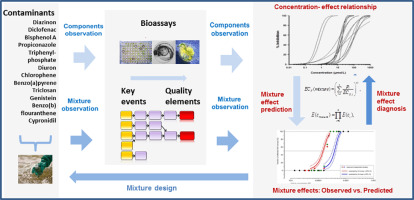Environment International ( IF 11.8 ) Pub Date : 2018-02-28 , DOI: 10.1016/j.envint.2018.02.013 Rolf Altenburger , Martin Scholze , Wibke Busch , Beate I. Escher , Gianina Jakobs , Martin Krauss , Janet Krüger , Peta A. Neale , Selim Ait-Aissa , Ana Catarina Almeida , Thomas-Benjamin Seiler , François Brion , Klára Hilscherová , Henner Hollert , Jiří Novák , Rita Schlichting , Hélène Serra , Ying Shao , Andrew Tindall , Knut Erik Tollefsen , Gisela Umbuzeiro , Tim D. Williams , Andreas Kortenkamp

|
Chemicals in the environment occur in mixtures rather than as individual entities. Environmental quality monitoring thus faces the challenge to comprehensively assess a multitude of contaminants and potential adverse effects. Effect-based methods have been suggested as complements to chemical analytical characterisation of complex pollution patterns. The regularly observed discrepancy between chemical and biological assessments of adverse effects due to contaminants in the field may be either due to unidentified contaminants or result from interactions of compounds in mixtures. Here, we present an interlaboratory study where individual compounds and their mixtures were investigated by extensive concentration-effect analysis using 19 different bioassays. The assay panel consisted of 5 whole organism assays measuring apical effects and 14 cell- and organism-based bioassays with more specific effect observations. Twelve organic water pollutants of diverse structure and unique known modes of action were studied individually and as mixtures mirroring exposure scenarios in freshwaters. We compared the observed mixture effects against component-based mixture effect predictions derived from additivity expectations (assumption of non-interaction). Most of the assays detected the mixture response of the active components as predicted even against a background of other inactive contaminants. When none of the mixture components showed any activity by themselves then the mixture also was without effects. The mixture effects observed using apical endpoints fell in the middle of a prediction window defined by the additivity predictions for concentration addition and independent action, reflecting well the diversity of the anticipated modes of action. In one case, an unexpectedly reduced solubility of one of the mixture components led to mixture responses that fell short of the predictions of both additivity mixture models. The majority of the specific cell- and organism-based endpoints produced mixture responses in agreement with the additivity expectation of concentration addition. Exceptionally, expected (additive) mixture response did not occur due to masking effects such as general toxicity from other compounds. Generally, deviations from an additivity expectation could be explained due to experimental factors, specific limitations of the effect endpoint or masking side effects such as cytotoxicity in in vitro assays. The majority of bioassays were able to quantitatively detect the predicted non-interactive, additive combined effect of the specifically bioactive compounds against a background of complex mixture of other chemicals in the sample. This supports the use of a combination of chemical and bioanalytical monitoring tools for the identification of chemicals that drive a specific mixture effect. Furthermore, we demonstrated that a panel of bioassays can provide a diverse profile of effect responses to a complex contaminated sample. This could be extended towards representing mixture adverse outcome pathways. Our findings support the ongoing development of bioanalytical tools for (i) compiling comprehensive effect-based batteries for water quality assessment, (ii) designing tailored surveillance methods to safeguard specific water uses, and (iii) devising strategies for effect-based diagnosis of complex contamination.
中文翻译:

多种污染物样品中的混合物效应–多种生物测定法的实验室间研究
环境中的化学物质以混合物形式而不是单个实体形式出现。因此,环境质量监测面临着全面评估多种污染物和潜在不利影响的挑战。已提出基于效果的方法作为复杂污染模式化学分析表征的补充。经常观察到的由于田间污染物造成的不利影响的化学和生物学评估之间的差异可能是由于不确定的污染物引起的,也可能是由于混合物中化合物相互作用的结果。在这里,我们进行了一项实验室间研究,其中使用19种不同的生物测定方法,通过广泛的浓度效应分析对单个化合物及其混合物进行了研究。该检测小组由5种测量根尖作用的全生物检测和14种基于细胞和有机体的生物检测以及更具体的观察结果组成。分别研究了十二种具有不同结构和独特已知作用方式的有机水污染物,并以混合物的形式反映了淡水中的暴露情况。我们将观察到的混合物效应与由可加性预期(不相互作用的假设)得出的基于组分的混合物效应预测进行了比较。大多数测定法甚至在其他非活性污染物的背景下也检测到了所预测的活性成分的混合反应。当混合物成分中的任何一个都不显示出任何活性时,则该混合物也没有作用。使用顶端终点观察到的混合效应落在由浓度增加和独立作用的可加性预测所定义的预测窗口的中间,很好地反映了预期作用方式的多样性。在一种情况下,一种混合物组分的溶解度出乎意料地降低,导致混合物响应低于两个可加性混合物模型的预测。大多数基于细胞和有机体的特定终点产生的混合反应与预期的浓度增加相符。例外地,由于掩盖效应(如来自其他化合物的一般毒性),未发生预期的(添加)混合物反应。通常,由于实验因素,可以解释与可加性期望值的偏差,作用终点的特定限制或掩盖副作用(例如体外试验中的细胞毒性)。大多数生物测定能够在样品中其他化学物质复杂混合的背景下,定量检测特定生物活性化合物的预测非相互作用,加和组合效应。这支持使用化学和生物分析监测工具的组合来识别驱动特定混合物效应的化学物质。此外,我们证明了一组生物测定可以提供对复杂受污染样品的效应响应的多种概况。这可以扩展到代表混合不良结果途径。



























 京公网安备 11010802027423号
京公网安备 11010802027423号